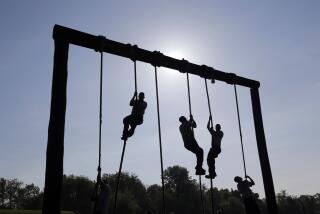Rock Climbing Takes Hold in Navy
BALTIMORE — After almost two centuries of sailing and seamanship, the midshipmen of the U.S. Naval Academy, bound for careers on the sea, are about to learn a new skill: rock climbing.
Starting this summer, before classes begin, the academy is requiring all freshmen to learn the basics of climbing and rappelling, with the help of its new $400,000 rock-climbing wall.
Officials are considering making rock climbing part of the school curriculum.
The 47-foot wall, one of the largest on the East Coast, was more than 10 years in the making, largely because of midshipmen’s efforts to win the support of the administration.
The trick, many midshipmen said, was to convince school officials of the physical and mental benefits.
The wall has been the subject of much discussion around the yard among longtime officers.
“As part of my official naval duties over the last 18 years, I can honestly say I have never had to climb a rock,” said Cmdr. Bill Spann, school spokesman, adding that he used to climb in college. “But I will definitely use it. It is a unique opportunity to have a facility of that caliber in your backyard.”
Lt. Gary Sullivan, who has headed the wall efforts on behalf of the students, said a weekly session has been set up for members of the academy’s faculty and staff to encourage them to give it a try.
More than one-fourth of the school’s 4,000 students have climbed the wall since it opened last week. Part of the interest, students say, is generational.
“Word’s just getting out, and it’s already getting crowded,” said senior Brad Wolf, the Brigade Climbing Wall officer, who is in charge of organizing supervision of the wall and instructing beginners.
“As long as there is something here on the wall to challenge somebody and give them something to think about, they’ll keep coming,” he said.
*
Midshipmen have always been required to learn sports unrelated to water. Fifteen years ago, it was badminton, tennis and gymnastics. Young adults today, raised on video games and “extreme sports,” find those activities dull, Sullivan said.
Vice Adm. John R. Ryan, the school’s superintendent, became convinced of the benefits of a climbing wall within a year of arriving at the academy in 1998. The selling point, according to the midshipmen who helped write the proposal, was noting that many comparable colleges across the country had such walls.
The wall is also good training for students planning to join the Marines or the Navy SEALs upon graduation, officials said.
The wall is enormous, filling the rear of the school’s indoor track facility. More than 30 students can climb at a time, supervised by a rotating shift of students.
It also has a rappel station on top and a plastic “stalactite” for those who want to try climbing by clinging to the wall by their fingertips upside down.
“It helps build self-confidence,” said junior Lindsay Fredericksen, who has wanted to see the wall built since she was a freshman. “When you come upon a hold that’s hard to reach, you really have to grasp for it. It also takes good teamwork and communication skills.”
In addition to the mandatory summer training for freshmen, the school has begun offering a rock-climbing elective that can fill the students’ quarterly physical education requirement.
As far as becoming part of the school’s curriculum, “it’s got a good chance,” Sullivan said. “The advantages of climbing both mentally and physically are a perfect fit. It complements what midshipmen are interested in doing in their personal time today.”


